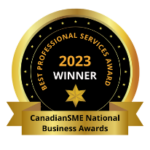
As Canada embarks upon a new stage of innovation, entrepreneurs are facing many challenges in an ultra-competitive environment. The goal of our event was to identify some common challenges and to receive some insights into how they were overcome by our panellists. Our panelists tackled a number of issues: how they came up with a brilliant idea, from ideation to creation, funding, building a team, the challenge of being young.
The Brilliant Idea
The first road block for a young entrepreneur is their first idea. Many of us come up with new ideas all the time, and more often than not we find out someone already thought of it first. So how do you get to “the idea”? Our panellists’ journey to a brilliant idea involved a very careful observation of their environment. This involved either finding an unaddressed need in an existing market or observing how technological advancements can provide the opportunity for developing new products and services for major industries.
“Then we put our product into the world and we really quickly realized there were a lot of people that were experiencing this problem. No matter where you were around the world, everybody was having this problem developing circuitry and being able to just accelerate their development.”
From Ideation to Creation
An idea is not enough to build a successful business. The next step is moving from ideation to creationThat involves developing a concrete execution plan, putting together a great team, and building a minimum viable product. All of our panellists found very creative ways to develop their ideas:
- Mark Ang tested and proofed the concept for creating a more convenient self-storage solution by going to the most under-served clients: undergraduate students. A zero-cost on-campus campaign generated $20k worth of monthly revenues. Along the way, he learned that he should raise more money to build the infrastructure instead of continuing to use his first storage partner (a logistics company). The journey was not always easy; he did have to do deliveries on his own in a rented U-Haul when demand could not be served otherwise. He did so while still acing his mid-term exam. Great job, Mark!
- Jenise Lee had to undertake the challenge of building a double-sided market when she set out to establish her own organic beauty product certification. She did not start by selling. She started by understanding the needs of her target companies through hundreds of hours of cold calls and interviews. By the time she set up the certification process, all these companies were already sold on the idea because it was a process set up directly to satisfy their needs and to help them deal with some of the challenges they were facing when reaching out to their own clients.
- Katarina Ilić confessed that her team started their journey with a mistake. They built a 4 by 5 inch platform, when most industrial applications require at least a 5 by 5 inch platform. This was the best mistake they ever made, because it resulted in one of the most valuable experiences for the company. It was a great opportunity to talk to thousands of their clients and really understand their needs. They built a new product with a perfect market fit and launched a Kickstarter campaign to fund themselves, and the business has been extremely successful ever since.
- Eric Lee managed to gain traction by taking advantage of the AI enthusiasm that captured everyone’s imagination back in 2015. They took the role of psychologists in predicting what senior executives really care about. At first, the focus was to build credibility. That meant taking a haircut on the first couple of projects. However, the success of those projects contributed tremendously to their brand reputation, which culminated in great success stories, such as the company being featured in the Wall Street Journal.
Funding
Funding to expand the company can come in various forms: crowdfunding, private investor rounds, or VC capital. The most important thing is to put it to good use and to make sure that every investment in the business results in tangible outcomes.
Building a Team
Investors will not only invest in an idea; they will invest in the entrepreneur and their team. Therefore, the team is an entrepreneur’s biggest asset. Some tips on creating a good company culture and keeping employees motivated are:
- maintaining constant communication with various touch points to show employees the value they create and the impact of their work, even if they are not client-facing
- making employees aware that a start-up environment allows them to grow much more than in a corporate environment, where they will always be capped even if they get promoted
- setting up an employee stock option plan to get them invested in the company through equity
- last but not least important, bring them muffins on Tuesdays
The Challenge of Being Young
When asked about the challenges and advantages of being young entrepreneurs, our panellists delivered a very good life lesson. That is, you shouldn’t see being young or being a woman, or part of any minority group as a blocker. The block comes when you let yourself feel like you are limited by it and fail to overcome.
This was a glimpse at the story of four successful and brilliant individuals. Entrepreneurship is not an easy path, but it is a path that they love, and they do not seem to regret taking.
Stay tuned for our next event this fall. We will continue the startup series, but this time we will focus on the investor perspective through a panel of investors (VC, PE, family office, angel investor, lender), in an event titled: “From Start To Growth: The Investor Perspective”.




